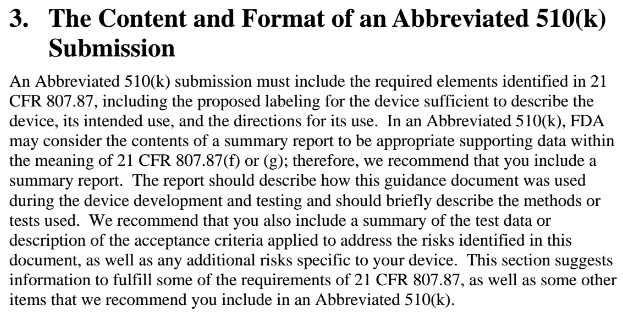The article briefly explains the three types of 510k submissions and identifies when you should be submitting an abbreviated 510k instead of a traditional 510k.
 Three types of 510k submissions
Three types of 510k submissions
The FDA has three different target timelines for reviewing a 510k submission and issuing a decision regarding substantial equivalence (i.e., SE Letter):
- Special 510k
- Abbreviated 510k
- Traditional 510k
Special 510k submissions
The first type is a special 510k submission. The FDA target timeline for a special 510k is 30 days, but you can only submit a Special 510k for a modification of your device that already has a 510k issued. Also, a Special 510k is only possible if the device modification requires a single technical discipline to review the change. For example, changes to software and materials require a review of software validation and biocompatibility. Therefore, two reviewer specialists must coordinate their efforts, and the review cannot be completed in 30 days. In this case, an abbreviated or traditional 510k must be submitted instead.
Abbreviated 510k submissions
The second type of 510k submission is an abbreviated 510k. The FDA target timeline for review is 60 days. If there is a recognized standard specific to the type of device you are submitting, or the FDA has issued a guidance document addressing that device classification, then an abbreviated 510k submission is recommended. For example, a dental handpiece (i.e., product code is ) has a special controls guidance document that explicitly written for dental handpieces, and the guidance states that an abbreviated 510k submission is recommended. Besides, the FDA recognizes the latest standard for dental handpieces: ISO 14457:2012 (FDA Doc # 4-206).
Traditional 510k submissions
The third type of 510k submission is a traditional 510k submission. The FDA target timeline for review is 90 days. If you are submitting a 510k for a new device, or the device modifications require more than one functional area of expertise, then a special 510k is not an option. If there is no recognized standard for the device type and the FDA has not issued the guidance of a special control for your device classification, then an abbreviated submission is also not an option. A traditional 510k submission is your only option in this case.
How frequently is an abbreviated 510k submission type used?
In September 2016, there were 260 510k SE decisions issued by the FDA. Here’s the breakdown by type:
- Special 510k – 47 submissions = 18%
- Abbreviated 510k – 8 submissions = 3%
- Traditional 510k – 205 submissions = 79%
In general, I think it requires a little more effort to write clear and concise summaries for the various sections of an abbreviated 510k than it does for a traditional 510k. But if you can get your product to market a month quicker then it’s worth it.
Additional Resources for 510k submissions
If you would like additional training on 510k submissions or you would like to access Medical Device Academy’s templates, you can purchase all of our templates and 510k webinars on our 510k course webpage.

Pingback: Third party review of 510(k) submissions – When it makes sense and which third party to choose? - Medical Device Academy Medical Device Academy
Pingback: Third Party Review of 510k Submissions - Medical Device Academy Medical Device Academy